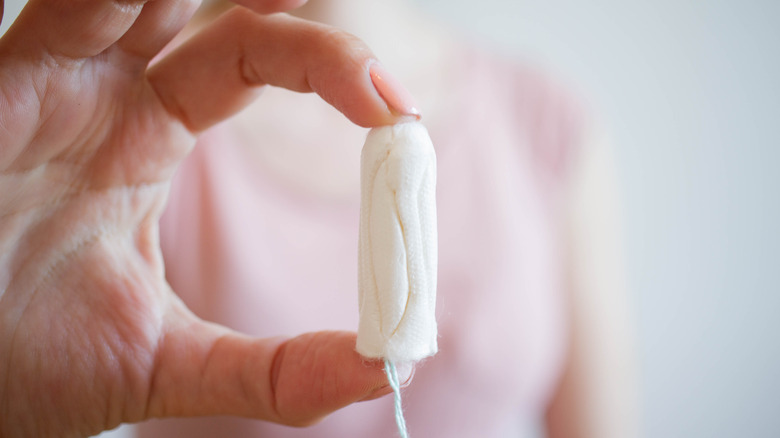Why You Should Think Twice Before Leaving A Tampon In For A Long Time
Sometimes, having a period can be unpleasant — and on top of all the discomfort, you also have to be vigilant about your menstrual health. If a tampon is left in too long, it could cause an overgrowth of the Staphylococcus aureus bacteria and lead to infection, according to WebMD.
The longer the tampon sits, the greater the likelihood that the bacteria will grow and release poisons that enter the bloodstream via the vaginal lining or uterus (via Healthline). This can cause a rare but life-threatening disease called toxic shock syndrome (TSS), which is a real concern for those who use tampons while menstruating.
Symptoms include a sudden high fever, a drop in blood pressure, nausea, vomiting, diarrhea, dizziness, and a rash that resembles a sunburn. The Food and Drug Administration (FDA) adds that you may also faint or feel like you might faint when you stand up. The FDA warns to stop using tampons and to seek immediate medical attention if you experience any of these symptoms during or shortly after your period.
The FDA recommends leaving a tampon in for no more than four to eight hours, making sure to use the lowest absorbency possible. If you are able to go a full eight hours without changing your tampon, the absorbency might be too high. It's never recommended to leave a tampon in for more than 8 hours, as this increases your risk for infection and TSS.
Why toxic shock syndrome is so serious
TSS is rare, affecting as few as 1 in 100,000 menstruating people each year, according to the National Organization for Rare Disorders. But you should still be careful not to put your body at risk.
A tampon soaked with blood is the perfect environment for bacteria to grow, especially if it's made from polyester rather than cotton (via WebMD). This buildup of bacteria can lead to the release of toxins. The body then responds to these toxins with a severe drop in blood pressure, which cuts off oxygen to organs. This can cause the heart and lungs to stop working, leading to death.
More than a third of people who get TSS are women under the age of 19, and 30% who get it will get it again. Treatment includes antibiotics, fluids, and medication for low blood pressure. If you experience any signs of TSS while menstruating, like a sudden high fever or dizziness, remove your tampon right away and contact your doctor.

